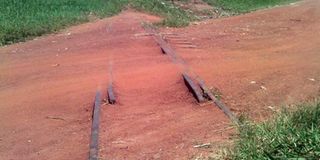Pakwach Railway line: The ignored link to development

Part of the Pakwach Railway line that has been left to waste over time. Although the railway line boosted business back then, since its destruction 20 years ago, the line has remained neglected. PHOTO by Felix Warom Okello.
What you need to know:
Transport. Despite having boosted economic activities and trade between Uganda and its neighbours, the Pakwach Railway line has since been left to ‘die’ a slow ‘death’, with the government now hatching plans to rejuvenate it.
West Nile
In 1969, Uganda launched one of its greatest investments ever. To witness the birth of the Pakwach Railway line, was Jomo Kenyatta, then Kenyan president and Julius Nyerere, then Tanznian president, standing besides their Ugandan counterpart Milton Obote.
The railway line, which today remains in sorry state, could have come in handy, boosting trade for Uganda and its neighbours South Sudan and DR Congo. However, years later, the billions of money spent in construction of the railway line have gone to rot after it was consumed by bush fire 20 years ago.
Recently though, a couple of people have been seen tracing the rails in the thicket bushes of the Murchison Falls Park, probably to rejuvenate it?
If the railway resumes operations, it would cut costs of road maintenance.
During the Obote I regime, construction of the railway line saw an instantaneous improvement in transportation, rapid growth of factories such as the Pakwach Ginnery and significant establishment of new technologies to increase agricultural production.
The railway was predominantly run by Africans and a few Indians.
According to an April 1964 document on East African Railway Developments by A.M O’Connor, the Ugandan government was anxious to have a bridge constructed at Pakwach and the railway extended further into West Nile.
This was, however, seen as more of a political rather than economic move, as the traffic prospects for such an extension were poor.
“There is no doubt the railway to the north whether or not it is taken beyond Pakwach, will provide a more convenient transport route to northern Uganda than the former route required four trans-shipments before the main line was joined,” the document reads in part.
From the early 1960s to 90s, there was abundant cotton for the South West Nile Co-operative Union and Arabica coffee from Okoro Coffee Growers’ Union. Both cooperatives were grounded following the collapse of the railway line and the eventual death of cooperative societies in Uganda.
To date, tobacco, cotton and coffee companies incur high costs of transportation using trucks. Moreover, unlike other industries which become modern over a period of time, railways changed technology at a much faster scale. It brought distant towns closer to mainstream cities such as Kampala and helped in improving commerce. Tobacco transportation from Arua was boosted.
In June 2006, the Chinese government pledged to build a railway extension from Pakwach to Juba. This failed, considering Juba is about 600km from Sudan Railways’ southernmost station at Waw.
Revival of the Railway business would help improve cross-border trade, should the Uganda and Sudan railways ever meet. There would be a break of gauge problem, which can be reduced by building the new tracks, with gauge convertible sleepers.
For 75-year-old John Ogenrwoth, a farmer, the railway would be an ideal means for transportation of bulky goods. “It was cheap for even a farmer in a village to transport goods to the cooperative society and later transport them to the railway point, which connects to other distant districts,” Mr Ogenrwoth said.
He added: “Our agricultural products such as cotton and food crops would be easily transported to other regions. And this will open market opportunities because most farmers cannot afford high transport costs, for example from Nebbi to Juba.”
In a recent press release, the general manager of Rift Valley Railway Uganda, Mr Mark Rumanyika, said the northern line was an important part of their concession and would play an increasingly strategic role in moving business forward.
He said since the landlocked South Sudan had recently become independent, commercially viable hydro-carbons discovered in the Albertine Graben and peace returned to the north, potential for business growth was virtually unlimited.
“Work on the northern line, expected to cost almost $2 million (Shs5b), commenced on November 19 last year and will undergo a three-phased approach. The first phase includes clearing bushes, and removing anthills,” Mr Rumanyika said.
The second phase will involve restoration of washed out areas due to flooding, especially in Soroti and installation of new culverts where required, while the final phase will involve replacement of vandalised locations.
Opening opportunities
Once reconstructed, the railway would also open up job opportunities for many. Most South Sudanese still use the Mombasa route to transport their goods either through Nimule, Bibia or Koboko-Yei routes.
Essentially, the Pakwach Railway line could offer a dramatic social, economic and cultural change, playing a pivotal role in development.
Finance Minister Maria Kiwanuka in this year’s Budget reading, said: “We are fast-tracking rehabilitation of Tororo-Pakwach and Kampala-Kasese railway lines.”
According to a feasibility study carried out in 2009 by Canarails Company, the upgrading of the 500km Tororo-Pakwach railway line, which has been inactive for decades, will cost Shs1.5 trillion.
While campaigning in Pakwach in 2011, UPC President Olara Otunnu, said: “West Nile was an island that was connected to the rest of Uganda in 1969 when the UPC government constructed the bridge and railway. We value the importance of railways and we will revive it.”
He noted that the transport system is now expensive due to the non-functionality of railways, which he says, provides cheap and faster transport network.




